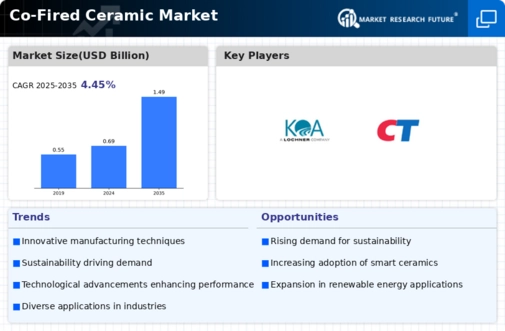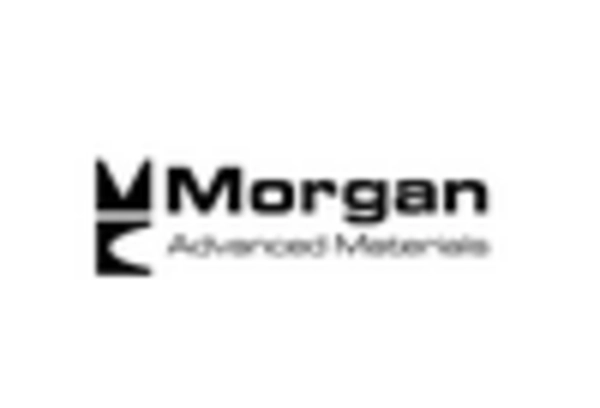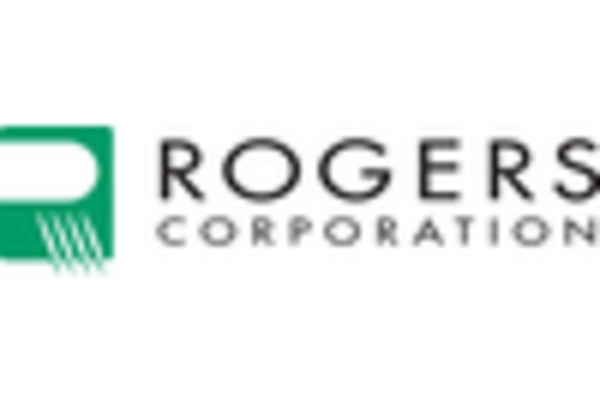-
Executive Summary
-
Scope of the Report
-
Market Definition
-
Scope of the Study
- Research Objectives
- Assumptions & Limitations
-
Market Structure
-
Market
-
Research Methodology
-
Research Process
-
Secondary Research
-
Primary Research
-
Forecast Model
-
Market Landscape
-
Supply Chain Analysis
-
Raw Material Suppliers
-
Manufacturers/Producers
-
Distributors/Retailers/Wholesalers/E-Commerce
-
End Users
-
Porter’s Five Forces Analysis
- Threat of New Entrants
- Bargaining Power of Buyers
- Bargaining Power of Suppliers
- Threat of Substitutes
- Intensity of Rivalry
-
Market Dynamics
-
of the Global Co-Fired Ceramic Market
-
Introduction
-
Drivers
-
Restraints
-
Opportunities
-
Challenges
-
Trends/Strategies
-
Global Co-Fired Ceramic Market, by Process Type
-
Introduction
-
Low Temperature Co-Fired Ceramic (LTCC)
- Market Estimates &
- Market Estimates & Forecast, by Region,
-
Forecast, 2020–2027
-
High Temperature Co-Fired Ceramic (HTCC)
- Market Estimates &
-
Market Estimates & Forecast, 2020–2027
-
Forecast, by Region, 2020–2027
-
Global Co-Fired Ceramic Market, by
-
Material
-
Introduction
-
Glass-Ceramic
- Market Estimates
- Market Estimates & Forecast, by Region,
-
& Forecast, 2020–2027
-
Ceramic
- Market Estimates & Forecast, 2020–2027
- Market Estimates & Forecast, by Region, 2020–2027
-
Global
-
Co-Fired Ceramic Market, by End-Use Industry
-
Introduction
-
Telecommunications
- Market Estimates & Forecast, 2020–2027
- Market Estimates
-
& Forecast, by Region, 2020–2027
-
Defense & Aerospace
- Market Estimates &
-
Market Estimates & Forecast, 2020–2027
-
Forecast, by Region, 2020–2027
-
Automotive
- Market Estimates
- Market Estimates & Forecast, by Region,
-
& Forecast, 2020–2027
-
Medical
- Market Estimates & Forecast, 2020–2027
- Market Estimates & Forecast, by Region, 2020–2027
-
Consumer
- Market Estimates & Forecast, 2020–2027
-
Electronics
-
Market Estimates & Forecast, by Region, 2020–2027
-
Others
- Market Estimates &
-
Market Estimates & Forecast, 2020–2027
-
Forecast, by Region, 2020–2027
-
Global Co-Fired Ceramic Market,
-
by Region
-
Introduction
-
North America
- Market Estimates
- Market Estimates & Forecast, by Process
- Market Estimates & Forecast, by Material, 2020–2027
- Market Estimates & Forecast, by End-Use Industry, 2020–2027
- US
-
& Forecast, 2020–2027
-
Type, 2020–2027
-
Market Estimates & Forecast, by Process Type, 2020–2027
-
Estimates & Forecast, by Material, 2020–2027
-
& Forecast, by End-Use Industry, 2020–2027
-
Market Estimates & Forecast, 2020–2027
-
Forecast, by Process Type, 2020–2027
-
by Material, 2020–2027
-
Industry, 2020–2027
-
Market
-
Market Estimates
-
Canada
-
Market Estimates &
-
Market Estimates & Forecast,
-
Market Estimates & Forecast, by End-Use
-
Europe
- Market Estimates & Forecast,
- Market Estimates & Forecast, by Process Type, 2020–2027
- Market Estimates & Forecast, by Material, 2020–2027
-
Market Estimates & Forecast, by End-Use Industry, 2020–2027
-
Germany
-
Market Estimates & Forecast, 2020–2027
-
Market Estimates & Forecast, by Process Type, 2020–2027
-
Estimates & Forecast, by Material, 2020–2027
-
& Forecast, by End-Use Industry, 2020–2027
-
Market Estimates & Forecast, 2020–2027
-
Forecast, by Process Type, 2020–2027
-
by Material, 2020–2027
-
Industry, 2020–2027
-
Market
-
Market Estimates
-
France
-
Market Estimates &
-
Market Estimates & Forecast,
-
Market Estimates & Forecast, by End-Use
-
Italy
-
Market Estimates & Forecast,
-
Market Estimates & Forecast, by Process Type, 2020–2027
-
Market Estimates & Forecast, by Material, 2020–2027
-
Market Estimates & Forecast, by End-Use Industry, 2020–2027
-
Spain
-
Market Estimates & Forecast, 2020–2027
-
Market Estimates & Forecast, by Process Type, 2020–2027
-
Estimates & Forecast, by Material, 2020–2027
-
& Forecast, by End-Use Industry, 2020–2027
-
Market Estimates & Forecast, 2020–2027
-
Forecast, by Process Type, 2020–2027
-
by Material, 2020–2027
-
Industry, 2020–2027
-
Forecast, 2020–2027
-
Type, 2020–2027
-
Market
-
Market Estimates
-
UK
-
Market Estimates &
-
Market Estimates & Forecast,
-
Market Estimates & Forecast, by End-Use
-
Russia
-
Market Estimates &
-
Market Estimates & Forecast, by Process
-
Market Estimates & Forecast, by Material,
-
Market Estimates & Forecast, by End-Use Industry,
-
Poland
-
Market Estimates & Forecast,
-
Market Estimates & Forecast, by Process Type,
-
Market Estimates & Forecast, by Material, 2020–2027
-
Market Estimates & Forecast, by End-Use Industry, 2020–2027
-
Rest of Europe
-
Market Estimates & Forecast, 2020–2027
-
Market Estimates & Forecast, by Process Type, 2020–2027
-
Market Estimates & Forecast, by Material, 2020–2027
-
Market Estimates & Forecast, by End-Use Industry, 2020–2027
-
Asia-Pacific
- Market Estimates & Forecast, 2020–2027
- Market Estimates
- Market Estimates &
- Market Estimates & Forecast,
- China
- India
-
& Forecast, by Process Type, 2020–2027
-
Forecast, by Material, 2020–2027
-
by End-Use Industry, 2020–2027
-
& Forecast, 2020–2027
-
Process Type, 2020–2027
-
Market Estimates & Forecast, by Material, 2020–2027
-
Estimates & Forecast, by End-Use Industry, 2020–2027
-
& Forecast, by Process Type, 2020–2027
-
Forecast, by Material, 2020–2027
-
by End-Use Industry, 2020–2027
-
Market Estimates & Forecast, 2020–2027
-
Forecast, by Process Type, 2020–2027
-
by Material, 2020–2027
-
Industry, 2020–2027
-
Forecast, 2020–2027
-
Type, 2020–2027
-
Market
-
Japan
-
Market Estimates & Forecast, 2020–2027
-
Market Estimates
-
Market Estimates &
-
Market Estimates & Forecast,
-
Australia & New Zealand
-
Market Estimates &
-
Market Estimates & Forecast,
-
Market Estimates & Forecast, by End-Use
-
Indonesia
-
Market Estimates &
-
Market Estimates & Forecast, by Process
-
Market Estimates & Forecast, by Material,
-
Market Estimates & Forecast, by End-Use Industry,
-
South Korea
-
Market Estimates & Forecast,
-
Market Estimates & Forecast, by Process Type,
-
Market Estimates & Forecast, by Material, 2020–2027
-
Market Estimates & Forecast, by End-Use Industry, 2020–2027
-
Rest of Asia-Pacific
-
Market Estimates & Forecast, 2020–2027
-
Market Estimates & Forecast, by Process Type, 2020–2027
-
Market Estimates & Forecast, by Material, 2020–2027
-
Market Estimates & Forecast, by End-Use Industry, 2020–2027
-
Middle East & Africa
-
Market Estimates & Forecast, 2020–2027
-
Market Estimates & Forecast, by Process Type, 2020–2027
-
Market Estimates & Forecast, by Material, 2020–2027
-
Estimates & Forecast, by End-Use Industry, 2020–2027
-
& Forecast, by Process Type, 2020–2027
-
Forecast, by Material, 2020–2027
-
by End-Use Industry, 2020–2027
-
& Forecast, 2020–2027
-
Process Type, 2020–2027
-
Market
-
GCC
-
Market Estimates & Forecast, 2020–2027
-
Market Estimates
-
Market Estimates &
-
Market Estimates & Forecast,
-
Israel
-
Market Estimates
-
Market Estimates & Forecast, by
-
Market Estimates & Forecast, by Material,
-
Market Estimates & Forecast, by End-Use Industry,
-
North Africa
-
Market Estimates & Forecast,
-
Market Estimates & Forecast, by Process Type, 2020–2027
-
Market Estimates & Forecast, by Material, 2020–2027
-
Market Estimates & Forecast, by End-Use Industry, 2020–2027
-
Turkey
-
Market Estimates & Forecast, 2020–2027
-
Market Estimates & Forecast, by Process Type, 2020–2027
-
Estimates & Forecast, by Material, 2020–2027
-
& Forecast, by End-Use Industry, 2020–2027
-
East & Africa
-
Market
-
Market Estimates
-
Rest of the Middle
-
Market Estimates & Forecast, 2020–2027
-
Market Estimates & Forecast, by Process Type, 2020–2027
-
Market Estimates & Forecast, by Material, 2020–2027
-
Estimates & Forecast, by End-Use Industry, 2020–2027
-
& Forecast, by Process Type, 2020–2027
-
Forecast, by Material, 2020–2027
-
by End-Use Industry, 2020–2027
-
& Forecast, 2020–2027
-
Process Type, 2020–2027
-
Market
-
Latin America
- Market Estimates & Forecast, 2020–2027
- Market Estimates
- Market Estimates &
- Market Estimates & Forecast,
- Brazil
- Mexico
-
Market Estimates & Forecast, by End-Use Industry, 2020–2027
-
Argentina
-
Market Estimates & Forecast, 2020–2027
-
Market Estimates & Forecast, by Process Type, 2020–2027
-
Estimates & Forecast, by Material, 2020–2027
-
& Forecast, by End-Use Industry, 2020–2027
-
Estimates & Forecast, by Process Type, 2020–2027
-
& Forecast, by Material, 2020–2027
-
Forecast, by End-Use Industry, 2020–2027
-
Market
-
Market Estimates
-
Rest of Latin America
-
Market Estimates & Forecast, 2020–2027
-
Market
-
Market Estimates
-
Market Estimates &
-
Company Landscape
-
Introduction
-
Market Strategy
-
Key Development Analysis
-
(Expansions/Mergers
-
& Acquisitions/Joint Ventures/New Material Developments/Agreements/Investments)
-
Company Profiles
-
DuPont (US)
- Company Overview
- Financial Updates
- Material/Business Segment Overview
- Key Developments
- SWOT Analysis
-
Strategy
-
Kyocera
- Company Overview
- Financial Updates
- Material/Business Segment Overview
- Strategy
- Key
- SWOT Analysis
-
Corporation (Japan)
-
Developments
-
TDK Corporation (Japan)
- Financial Updates
- Material/Business Segment
- Strategy
- Key Developments
- SWOT Analysis
-
Company Overview
-
Overview
-
KOA Corporation (Japan)
- Company Overview
- Financial
- Material/Business Segment Overview
- Strategy
- Key Developments
- SWOT Analysis
-
Updates
-
HitachiMetals, Ltd
- Company Overview
- Financial Updates
- Strategy
- Key Developments
- SWOT Analysis
-
(Japan)
-
Material/Business Segment Overview
-
CeramTec (Germany)
- Company Overview
- Financial Updates
- Material/Business Segment Overview
- Key Developments
- SWOT Analysis
-
Strategy
-
Yokowo
- Company Overview
- Financial Updates
- Material/Business Segment Overview
- Strategy
- Key
- SWOT Analysis
-
Co., Ltd (Japan)
-
Developments
-
Murata Manufacturing Co., Ltd (Japan)
- Company Overview
- Financial Updates
- Material/Business
- Strategy
- Key Developments
-
Segment Overview
-
SWOT Analysis
-
NGK Spark Plug Co. Ltd (Japan)
- Company Overview
- Financial Updates
- Material/Business Segment Overview
- Key Developments
- SWOT Analysis
-
Strategy
-
Micro
- Company Overview
- Financial
- Material/Business Segment Overview
- Strategy
- Key Developments
- SWOT Analysis
-
Systems Technologies (Switzerland)
-
Updates
-
Murawa Co.
- Company Overview
- Financial Updates
- Strategy
- Key Developments
- SWOT Analysis
-
Ltd (Japan)
-
Material/Business Segment Overview
-
Nikko Company (Japan)
- Company Overview
- Financial Updates
- Material/Business Segment Overview
- Strategy
- Key Developments
- SWOT Analysis
-
IMST GmbH (Germany)
- Company Overview
- Financial
- Material/Business Segment Overview
- Strategy
- Key Developments
- SWOT Analysis
-
Updates
-
API Technologies
- Company Overview
- Financial Updates
- Strategy
- Key Developments
- SWOT Analysis
-
(UK)
-
Material/Business Segment Overview
-
Selmic Oy (Finland)
- Company Overview
- Financial Updates
- Material/Business Segment Overview
- Strategy
- Key Developments
- SWOT Analysis
-
Conclusion
-
LIST OF TABLES
-
Global
-
Co-Fired Ceramic Market, by Region, 2020–2027
-
North America:
-
Co-Fired Ceramic Market, by Country, 2020–2027
-
Europe: Co-Fired
-
Ceramic Market, by Country, 2020–2027
-
Asia-Pacific: Co-Fired
-
Ceramic Market, by Country, 2020–2027
-
Middle East & Africa:
-
Co-Fired Ceramic Market, by Country, 2020–2027
-
Latin America:
-
Co-Fired Ceramic Market, by Country, 2020–2027
-
Global Co-Fired
-
Ceramic Process Type Market, by Region, 2020–2027
-
North America:
-
Co-Fired Ceramic Process Type Market, by Country, 2020–2027
-
Table 9
-
Europe: Co-Fired Ceramic Process Type Market, by Country, 2020–2027
-
Table10
-
Asia-Pacific: Co-Fired Ceramic Process Type Market, by Country, 2020–2027
-
Table11 Middle East & Africa: Co-Fired Ceramic Process Type Market, by
-
Country, 2020–2027
-
Table12 Latin America: Co-Fired Ceramic Process Type
-
Market, by Country, 2020–2027
-
Table13 Global Co-Fired Ceramic Material
-
Market, by Region, 2020–2027
-
Table14 North America: Co-Fired Ceramic
-
Material Market, by Country, 2020–2027
-
Table15 Europe: Co-Fired Ceramic
-
Material Market, by Country, 2020–2027
-
Table16 Asia-Pacific: Co-Fired
-
Ceramic Material Market, by Country, 2020–2027
-
Table17 Middle East &
-
Africa: Co-Fired Ceramic Material Market, by Country, 2020–2027
-
Table18
-
Latin America: Co-Fired Ceramic Material Market, by Country, 2020–2027
-
Table19 Global Co-Fired Ceramic End-Use Industry Market, by Region, 2020–2027
-
Table20 North America: Co-Fired Ceramic End-Use Industry Market, by Country, 2020–2027
-
Table21 Europe: Co-Fired Ceramic End-Use Industry Market, by Country, 2020–2027
-
Table22 Asia-Pacific: Co-Fired Ceramic End-Use Industry Market, by Country,
-
Table23 Middle East & Africa: Co-Fired Ceramic End-Use
-
Industry Market, by Country, 2020–2027
-
Table24 Latin America: Co-Fired
-
Ceramic End-Use Industry Market, by Country, 2020–2027
-
Table25 Global
-
Process Type Market, by Region, 2020–2027
-
Table26 Global Material Market,
-
by Region, 2020–2027
-
Table27 Global End-Use Industry Market, by Region,
-
Table28 North America: Co-Fired Ceramic Market, by Country
-
Table29 North America: Co-Fired Ceramic Market, by Process Type
-
Table30
-
North America: Co-Fired Ceramic Market, by Material
-
Table31 North America:
-
Co-Fired Ceramic Market, by End-Use Industry
-
Table32 Europe: Co-Fired Ceramic
-
Market, by Country
-
Table33 Europe: Co-Fired Ceramic Market, by Process Type
-
Table34 Europe: Co-Fired Ceramic Market, by Material
-
Table35 Europe: Co-Fired
-
Ceramic Market, by End-Use Industry
-
Table36 Asia-Pacific: Co-Fired Ceramic
-
Market, by Country
-
Table37 Asia-Pacific: Co-Fired Ceramic Market, by Process
-
Type
-
Table38 Asia-Pacific: Co-Fired Ceramic Market, by Material
-
Table39
-
Asia-Pacific: Co-Fired Ceramic Market, by End-Use Industry
-
Table40 Middle East
-
& Africa: Co-Fired Ceramic Market, by Country
-
Table41 Middle East &
-
Africa Co-Fired Ceramic Market, by Process Type
-
Table42 Middle East & Africa
-
Co-Fired Ceramic Market, by Material
-
Table43 Middle East & Africa: Co-Fired
-
Ceramic Market, by End-Use Industry
-
Table44 Latin America: Co-Fired Ceramic
-
Market, by Country
-
Table45 Latin America Co-Fired Ceramic Market, by Process
-
Type
-
Table46 Latin America Co-Fired Ceramic Market, by Material
-
Table47
-
Latin America: Co-Fired Ceramic Market, by End-Use Industry
-
LIST
-
OF FIGURES
-
Global Co-Fired Ceramic Market Segmentation
-
FIGURE
-
Forecast Research Methodology
-
Porter’s Five Forces Analysis
-
of the Global Co-Fired Ceramic Market
-
Value Chain of the Global Co-Fired
-
Ceramic Market
-
Share of the Global Co-Fired Ceramic Market in 2020,
-
by Country (%)
-
Global Co-Fired Ceramic Market, 2020–2027 (USD
-
Million)
-
Global Co-Fired Ceramic Market Size, by Process Type, 2020
-
(USD Million)
-
Share of the Global Co-Fired Ceramic Market, by Process
-
Type, 2020–2027 (%)
-
Global Co-Fired Ceramic Market Size, by
-
Material, 2020 (USD Million)
-
Share of the Global Co-Fired Ceramic
-
Market, by Material, 2020–2027 (%)
-
Global Co-Fired Ceramic
-
Market Size, by End-Use Industry, 2020 (USD Million)
-
Share of the
-
Global Co-Fired Ceramic Market, by End-Use Industry, 2020–2027 (%)

















Leave a Comment